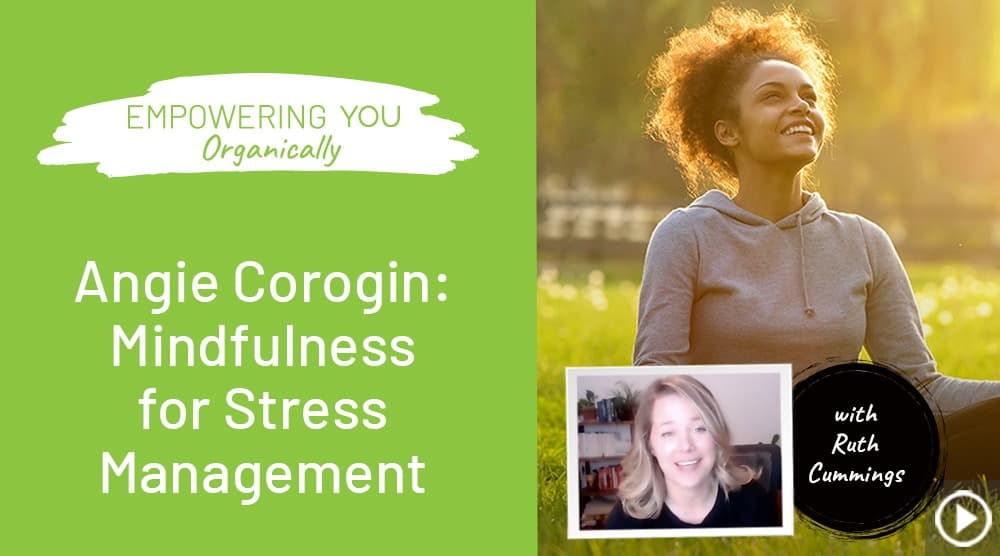Empowering You Organically – Season 12 – Episode 109
Title: Angie Corogin: Mindfulness for Stress Management
Hosts: Joni Jones
Guest: Angie Corogin, MEd, ERYT200, RYT500 – Mindfulness Educator & Mindset Coach
Description: The Live It Challenge continues with Angie Corogin. 2020 has been a stressful year for the world. Today is all about stress and mindfulness. Angie shares how the practice of mindfulness may help you meet challenge and stress differently. And you will enjoy the exercises Angie walks us through as she explains. Relaxation here you come…
* * *
FEATURED PRODUCT
This Powerful Anti-Inflammatory Supports a Healthy Heart, Boosts the Thyroid, and Promotes Brain Function
- 3 NATURAL INFLAMMATORY SUPPORT AGENTS:Our revolutionary formula combines Frankincense, Myrrh & organic fermented Turmeric into a powerhouse anti-inflammatory supplement.
- SOOTHE ACHING JOINTS: Each of these ancient treasures has been shown through studies to help alleviate joint pain, soothe aching joints and decrease inflammation.
- INCREASE MEMORY & ALERTNESS:Frankincense has been scientifically demonstrated to support a healthy heart, support normal thyroid function, and promote memory and brain function.
- CLEAN INGREDIENTS:We use only the purest and cleanest ingredients. Our Joint & Muscle Care contains all natural ingredients free from fillers, binders and excipients.
* * *
Angie Corogin
Angie is a heartful yoga and mindfulness (MBSR) instructor, yoga studio owner, mindset coach, and certified integrative wellness consultant. She supports communities, corporations, and individuals to integrate functional wellness practices into their modern lives. Angie is committed to an earth-conscious lifestyle, from what she eats & drinks to all of the things that she consumes and is inspired to share this way of life with others. Angie has earned degrees in Environmental Education (B.S.) and Intervention Services (M.Ed).
Mindfulness
Today is all about stress and mindfulness. I would like to share how the practice of mindfulness may help you meet challenge and stress differently.
These practices are easy, nothing you haven’t done before, however, this is not so simple.
Let’s start with a practice, I invite you to minimize all of the extra windows on your devices or life, begin to gather yourself here. Totally here. Calling yourself back from all of the places that you are.
Short Attentional Focus Practice
5-Sense Pause (look around, hands/feet, soundscape, soften the mouth/jaw, breath)
Rub hands, eyes / tap forehead, temples, cheeks, chin, chest
Brush off arms and shoulders
SH massage / GB 21 (neck, shoulder, headaches, too much thinking)
Standing Yoga
Mountain/ arms up & down
Edges of feet, ankle rocks
Knees
Hips
Swing arms/chair
Sunflowers
Mountain
Sit/ Thymus thumps
We took that time to practice because we can use all of these words to point at what mindfulness is. We can quote studies, articles, and interview experts too, but we really can only know mindfulness through the direct experience of the practice, our own practice of paying attention. And now, I am going to attempt to use words to describe stress and mindfulness, which are both, felt and known by each of us… and known by us differently. We all describe stress and mindfulness a little different.
Definition of Stress
I’d wage that humans have been feeling stress since day 1. This look at stress with the lens of science is relatively new. Researchers have had a difficult time agreeing on an acceptable definition of stress. Some have conceptualized stress as a demanding or threatening happening or situation (e.g., a high-stress job, overcrowding, and long commutes to work). Such conceptualizations are known as stimulus-based definitions because they characterize stress as a stimulus that causes certain reactions.
But stress is more than that. Stress is something that we each feel. Stress is the state which is seen in response to internal or external stressors. And here is what I think, its difficult to define something that is so…so individually experienced. Every system of the body responds to stress in varying ways. Sweating, quickened breath, fast heartbeat or skipping beats, holding our breath, blinking a lot, it can manifest in as many ways different as we are different from one another.
Stress enlists changes affecting almost every system of the body, influencing how people feel and behave.
History of Stress
I want to zoom back in time a bit and keeping this brief, but I want to go back to something I said. The “formal” study of stress is relatively new so lets have a quick chat about that.
In the 30’s Walter Cannon coined flight or flight. He was studying dogs swallowing buttons, and the swallowing mechanism. He discovered emotions impacted this somehow. He found fight and flight.
Fight I can meet this challenge.
Flight I can flee this challenge.
Around the same time Hans Seyle was exploring the concept of general adaptation syndrome, a study on stress, any kind – mind, body, emotions. When we encounter stress, especially when its prolonged our body biology changes.
It 1984 Stress researchers Lazarus and Folkman at Berkeley expanded and proposed a way to look at stress differently. Their transactional theory of stress considered stress as a transaction between a person and their environment that is appraised as taxing or exceeding resources and endangering their well-being.
So, this theory introduces the idea that our perception of the stressor could be the source of stress. Stress is transactional.
Let me break it down. We have some awareness we can bring to assess our ability to meet our stress. Ex. I’m making a new meal for dinner and am excited to share it with my husband, he was supposed to be home at 6, and rolls in at 630… I’m frustrated and disappointed and trying to figure out how to enjoy the cold meal. It’s the next day, dinner is at 6, I’m busy at work, I have NO idea what to make and need extra time. He gets home at 6:30 and I’m relieved. Same situation, my appraisal of it is different.
OK, so what can we do with all of that. Stress has been defined in lots of ways; we know it in our own way. A powerful, a potent antidote to stress… is mindfulness.
Definition of Mindfulness
Mindfulness is awareness that arises through paying attention, on purpose, in the present moment, non-judgmentally, in the service of self-understanding and wisdom.” JKZ
It is holding our attention to whatever is rising. Being here. HumanBEING not humanDOING. This can be hard at first, boring, restless, thinking we aren’t doing it right.
We sense the world through, hearing, tasting, touching, seeing. That is our only way to know anything at all. Our senses inform our thoughts. And this is our perception, from where we form opinions and then make decisions and hold positions. Its a completely a personal experience but one that we can often collectively understand and benefit from sharing our experience with others.
Mindfulness-Based Stress Reduction (MBSR).
The timelines of stress research and mindfulness research start to merge in 1979. Jon Kabat-Zinn recruited chronically ill patients not responding well to traditional treatments to participate in his newly formed eight-week stress-reduction program, which we now call Mindfulness-Based Stress Reduction (MBSR). This program includes mindful meditation, mindful eating, walking, and mindful movement (aka gentle yoga).
Substantial research has mounted demonstrating how mindfulness-based interventions improve mental and physical health—comparably so to other psychological interventions
Our body is a partner to each moment. Here in the west, we spend a lot of time disconnecting from our body. Body shaming, and in fact spending a whole lot of time up here, in the mind, thinking.
And so again, mindfulness – paying attention for the sake of paying attention. We can start to recognize our habitual patterns. Knowing our patterns can really change things.
You can do this practice long, short, in a car, while washing dishes, having a cup of tea, eating a meal, walking, in the shower. Mindfulness can be invited into each and every moment. It’s a practice, not a performance. We just keep coming back to each moment. Giving each moment incredible value, importance and attention.
Simple right, not so easy. A very important aspect of mindfulness is bringing an attitude of kindness to our own self. Right, what’s that? Yes, being kind to ourselves is a thing.
Visualizing Resistance
Make a fist. This is resistance. Resistance in your body, mind and soul.
Try to pry it open. Come on, pry it open. What do you notice when you pry and push?
Now use the other hand to support and be kind. Now what do you notice? Powerful because we can feel it. You can use this in your practice because you can actually do this.
Stress is a sense of threat. Things happening that I don’t want to happen. OR wanting a particular thing to happen that is not.
So, what is this hand, what is support to your stress….
A deep breath.
Counting to three.
Looking around, find a few green or blue things.
Feel your feet, hand.
Sense into the sounds around you.
Take a deeper breath.
Breathing is a huge tool for many of us that we underutilize.
Parts of Brain
Our stress response is hard-wired, automatic, habitual. When we experience a threat, the automatic sympathetic nervous system goes into high gear (with signals from the brain stem and limbic system).
Different parts of the brain are responsible for initiating this automatic reaction:
This here is the brain stem and is the earliest part of the brain to form was what many refer to as our reptilian or lizard brain (brain stem). This is the survival part of our brain.
Responsible for basic survival—keeps our hearts beating, keeps us breathing.
Lizards that weren’t vigilant enough ended up getting eaten, which is why this part of the brain is hardwired to feel a constant, vigilant anxiety.
Next part of the brain to evolve was the mammal or mouse brain (limbic system – amygdala, hippocampus) regulates our emotions and desires. Its main job is to move us toward the things that maintain life. The amygdala is the smoke alarm, detecting stress.
The most recent part of our brain to evolve is the primate or monkey brain (cortex) handles the higher cerebral functions—thinking critically, problem solving, planning, making mental maps of our world, and connecting with others. In essence, our online brain. Monkeys that weren’t able to connect with other monkeys did not survive.
When encountering stress or a challenge that we appraise outside of our ability to meet. Thinking goes out the window and our prefrontal cortex goes offline. We are operating from the lizard and mouse like part of our brain.
Fortunately, most of the time we do not find ourselves encountering life-threatening situations.
Unfortunately, physiologic responses to non-immediate stresses are largely the same as when you’re fighting for survival. Our body doesn’t know the difference. But we can tell it!
We’re still prone to go into fight or flight when our sense of control is threatened, even if we’re just driving on the freeway or we receive harsh feedback from coworkers. Our brain still perceives events in terms of mortal threats to our well-being and sense of self, even when there is none.
THIS IS AUTOMATIC, HARD-WIRED, HABITUAL REACTION FINE-TUNED FOR SURVIVAL.
SO, what can you do?
If it’s a non-life-threatening moment, we can one – breathe. Take a few breaths. Let your prefrontal cortex come back online. You might want to sit or lay down, lower your eyes, take a slow walk.
Most of all, we can get to know how stress feels as it begins in our body. We can also develop wisdom in how to support ourself in the heat of the moment. In the senses, we can often find a way back to homeostasis.
“We can’t stop the wild and painful catastrophes of life, but we can learn to cope.” JKZ or as
Thich Nhat Hanh, the Vietnamese Buddhist monk and revered teacher says, “Without the mud, you cannot grow the lotus flower.”
Breath Focus Practice
Take a moment and find something to let your eyes rest on. Soften your gaze but looking. You might like to rest your hands…. And when it is comfortable begin to let your eye lids lower, any amount or all of the way closed. Feel yourself sitting, standing, know what you can about being right here. Only this moment matters right now. What can be known? Begin to look at the inside of the eyes. Look with awareness. Look to know, to see what’s there.
Move your attention to your breath. You might even feel this ability to look inward at the breath. From any perspective that you can you know the breath. From the nose, the nostrils, the throat, the chest, or ribs moving or belly. You might sense warmth and then cool as your breath enters and leaves.
And then gently open your eyes again. And continue to look with this awareness.
* * *
Subscribe to Empowering You Organically
Never miss an episode!





